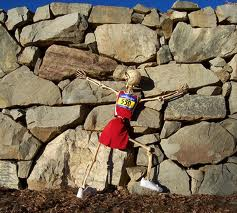I was 14 miles into a 16 mile run when it really hit me. It had known it was coming for a few miles but still miles from home and having consumed my only gel, there was nothing I could do about it. Almost immediately, I went from feeling quite good, to having absolutely no energy. My legs turned to jelly and I was finding it hard just to put one foot in front of the other. It also effected my mental state, so much so that I nearly ran out in front of a car! I had it the wall, in a big way...
Anyone who has experienced this will know how horrible it feels. I ate like a horse when I got in in the hope of restoring my energy levels and tried to rest but I still feel rubbish today. It did however, make me think that this was a good topic to write about.
 |
| Hitting the wall can hurt! |
Most people who are about to embark upon training for a marathon will have heard of the dreaded wall. In fact, even non-runners know about it and will ask, "did you hit the wall?" when you are talking about your marathon experience. But despite it being quite a well known term, most people don't actually know what hitting the wall is, or how you can avoid it. Often, people think it is just about running far enough in training, so your legs are accustomed to running 26.2 miles.
In fact, it has little to do with how fit you are or how well you have trained. You may have had perfect training and completed all of your training sessions and long runs but if you get your nutrition strategy wrong, you will run out of energy and hit the wall at some point during your marathon.
Here is a very simple explanation of what happens to your body when you hit the wall. Your body uses something called glycogen as it's primary fuel when you are running (during long, slow duration exercise, fat can help fuel activity, but glycogen is still needed to help breakdown the fat into something the muscles can use). When you have used up all of your glycogen stores, you hit the wall.
The trick is to keep your levels of glycogen topped up. Glycogen is what your body metabolises from carbohydrates, which is why you will hear people saying that they are 'carb loading' on the lead up to running a marathon. This is to try and ensure that they have as much glycogen stored in their liver and muscles. Now, before you think about eating 5 pasta meals and 10 chocolate bars the day before your marathon, your body can only store a certain amount of carbs as glycogen. The rest is stored as fat, so beware!
Everyone is different but, on average, your body can store enough glycogen for about one and a half hours of strenuous exercise. The more strenuous, the exercise, the more quickly you will use the energy (glycogen) and once this has completely gone, you will hit the wall.
Most first time marathoners will be running for 4 or 5 hours, or more. In fact many of your training runs may be in excess of 3 hours. So, it doesn't matter how well you have fuelled beforehand, you will run out of energy at some point. This is where fuelling during your run comes in. This food/fuel normally consists of energy drinks / gels / jelly beans or a combination of the above. We use this type of fuel because it is easy to consume on the run and easier for your body to digest during exercise. After all, would you feel like eating a plate of spaghetti 15 miles into a marathon?!
The only way to ensure that you don't run out of fuel and hit the wall during your marathon is to practise your fuelling and re-fuelling strategy during your long training runs. As I mentioned before, peoples metabolisms are different and their fuelling needs may vary greatly. You will also find that, over time, your body becomes more accustomed to endurance exercise and therefore more efficient at using it's fuel stores. I used to start run out of energy after about an hour to an hour and half of exercise. Now I can often go for 2 hours before I start to feel my energy levels dropping.
So, it will require some trial and error. If in doubt, it is better to take more gels with you on your training runs (unlike me on Sunday!) and if you do feel your energy levels dropping, do react to this because if you do hit the wall, it is very difficult to restore your energy levels and recover to the point where you can carry on running.
One final warning. Once you have found a fuelling strategy (both pre-race and during the race) make sure you stick to it on race day. Do this and you can avoid hitting the dreaded wall.
Good luck!

No comments:
Post a Comment